Before I review the recent film, what follows sets the scene for the historical event, details largely absent from the film.
Staff work is never celebrated and when it works, it passes unnoticed. The Royal Navy began planning for a mass withdrawal of the British Expeditionary Force, including directly from beaches, six days before the first lift occurred. Procedures were elaborated, the wording of simple and clear orders hammered out and communicated, beach wardens designated and briefings written for them, auditing began of flat-bottomed small craft on RN vessels, estimates made of rates of embarkation per hour under fire, distribution of medicine and field dressings to RN ships begun, drafting medical personnel and assigning them to ships started, listing civilian craft in southern ports was started, decks were cleared on RN transports, and so and on. Operation Dynamo started long before the first Tommie got wet.
Operating at the limit of the range of fighter aircraft from England, the Royal Air Force flew more than a hundred missions over Dunkirk during the evacuation. However, no one could guess at the timing of German attacks and so The RAF was often absent when the Luftwaffe was present and vice versa.
Nearly all of those evacuated were taken off piers and moles on RN boats and transferred to warships. The sea around Dunkirk beaches, by the way, is shallow, meaning the larger ships had to stand well out, and it was a long transfer from shore to ship. Six or more RN ships were sunk by German air attacks with much loss of life. At the initiative of their captains, some French ships also loaded troops, and likewise some French ships were sunk.
The French defence of a line around Lille resisted for four days against a superior force holding ten German divisions off Dunkirk, and that reduced the pressure on the perimeter. In the end much of Lille was levelled by house-to-house fighting. The town of Dunkirk itself was obliterated by artillery fire. By the way. These battles are seldom mentioned in the British accounts of Dunkirk. By the way, Lille was the hometown of Charles de Gaulle and members of his family died in this struggle.
Nearly all of the little ships that participated in the exercise had Royal Navy personnel on board, though often a very junior cadet, partly this was to honour the legality of impressing the boats into service and indemnifying the owners and civilian crew. The little ships ferried men from the beaches to the ships, and some sailed directly back to England, like that of Mr Miniver. One estimate suggests six thousand men were evacuated directly to England by little, civilian water craft. I have seen that said as ‘only six thousand’ out of the more than 330,000. True that is less than .02 percent. But it is 6,000 individuals welcomed home from the cauldron and as a whole they amount to a light division which later any general later would be glad to have.
While there was planning and preparation, there was also disruption and confusion. Much fell to the initiative to those on the spot. That initiative worked as well as it did in large part because of the planning that set the scene.
French troops had fallen back onto the line Dunkirk – Ostend which was slowly collapsing. There was no plan for them to do anything but fight. Communication between French field commands and headquarters were cut, and communication among the field commands was likewise nearly zero. (Much of the responsibility for the loss of communication must go to French High Command which refused the use of field radios.) Without communication, without orders, responsibility fell down the chain of command ever lower in an army that did not prize initiative.
When the British evacuations began, the French troops in the area had no orders. Some individuals made up their own minds and tried to join in. The best way was to change coats by peeling one off a deadman and trying to look English.
At times French officers on their own initiative tried to board their men in units, and some were successful and others were turned aside. This refusal to board some of the French was reported to Prime Minister Winston Churchill by British army officers, and Churchill immediately ordered that there be no discrimination but rather first come, first boarded. This applied to the French, the Belgians, the Dutch, and even some Poles and Czechs who were there.
There was the germ of a plan, hatched by the French Under-Secretary of State for War in the Reynaud Government to withdraw to the Cotentin peninsula in Western Normandy. Troops evacuated from Dunkirk could be fed into that plan. That Secretary of State was General Charles de Gaulle.
The 100,000 French troops disembarked in England from Dunkirk spent only two or three days there. They were entrained to Bristol, Swansea, and other western ports and shipped to Bordeaux while the war continued.
While French Prime Minister Paul Reynaud wanted to fight on, the generals at the French meeting table were defeated. They convinced the majority of cabinet that further resistance was futile. The cabinet asked the President, a figurehead, to empower Phillipe Pétain to ask what terms the Germans would offer. That was his mandate when named prime minister of a one-man government. Instead he surrendered without any effort at negotiation. Doubtless negotiation would have failed but the effort might have bought a little more time and much more dignity. But that surrender without the effort rendered the legitimacy of his claim to government suspect to many.
While 200,000+ men of the British Expeditionary Force were evacuated at Dunkirk, thousands of others were evacuated about the same time along the north coast, and later more than 100,000 others from the west coast of France. These other evacuations were less heroic and are not well known as a result but each was done in difficult circumstances. The shallow waters off Dunkirk kept the U-Boats away but not so off Bordeaux.
That Dunkirk became a moral victory has a simple but overlooked explanation. With the impulses of a democratic politician, Churchill who had become prime minister on the day Dynamo started, went to Waterloo Station in London to see for himself the battered and wounded troops returning from the south coast. As he walked among them, they cheered him and he they; he put his hat on his walking stick, and his resolve to fight on multiplied. Democracy at work. They were beaten but not defeated and he got the message.
At Dunkirk the decisions were many. When the Germans broke through at Sedan, one prong drove to the sea to cut off the British Expeditionary Force there and the two French armies in Belgium, while another drove at Paris to decapitate the French government. The French resistance was stiff in some places, like Lille, yet in other places it dissolved. The RAF decided to withdraw its aircraft from Frenchg airfields to England, lest their airplanes, fall into the hands of the advancing Germans, to save its assets to fight another day. This RAF withdrawal outraged many Frenchmen who hoped they would fight on, come what may. Here national interests diverged among the Allies. It seemed all or nothing right now for the French, but the English could wait to fight again another day.
Hmm, but the French did have an alternative, one that Reynauld proffered without success. To take the government into exile to Algiers and continue the war from the vast French Empire with the imperial army. There might have been another day for them, too. One of his generals had an airplane fuelled and ready to do just that.
While some French officers thought the British evacuation was a betrayal, that sentiment is largely hindsight. At the time, a withdrawal kept those troops, a third of them French, in the war and not in prison camps which was the fate of those who remained. Most of the defence of the Dunkirk perimeter fell to the French who held longer than the Germans had estimated they could.
That the Germans did not go all out against Dunkirk seems to be the conclusion. Why not? Partly because the strategic goal was Paris, and not Dunkirk. Most of the Luftwaffe efforts were directed to that end. As terrible as the Luftwaffe attacks on Dunkirk beaches and shipping were, most of its efforts went to paving the way for the advance on Paris.
It is also true that the German forces attacking Dunkirk were at the end of an attenuated and nearly exhausted supply line. Petrol, ammunition, medical care, medicines, fresh water, tires and treads, field dressings, food, oil, replacement parts, boot laces, all of these were depleted, as were the men. Machines were breaking down from two weeks of continuous use. The Germans had to slow down to recuperate and re-new energies. The horses that carried the vast bulk of the supplies were knackered.
There are other explanations that seem less credible. One is that Hitler gave the stop order, rather than just agreed to it, to open negotiations with England. Some connect this speculation to Rudolph Hess’s earlier flight. It seems a long bow. The best way to negotiate with England would be from strength by capturing the British Expeditionary Force which had in its ranks the vast bulk of England’s professional army at the time, that part which was not in the impregnable fortress of Singapore.
Another explanation is that Hitler wanted his genius recognised and gave the stop order to show the generals who was in charge. It fits the man, but it does not explain why the stop continued as long as it did. What explains the duration is the re-supply of the Wehrmacht and also that the forces in the north had a second-order priority compared to the forces driving onto Paris. This latter offensive is neglected by British accounts because their were no British troops involved, only French, of whom thousands died.
There was no hurry because the German supposition, based on its own staff work, was that most of the men trapped in and around Dunkirk had no where to go. What surprised the Germans was that the evacuation worked. Their staff work concluded that an evacuation would lift about 40,000 men plus of minus ten percent, and leave the rest. Ergo, the German General Staff did not see any reason to spend its assets at Dunkirk.
While the Luftwaffe attacked the evacuating ships at piers there were few U-Boat in those waters. Most were patrolling in the North Atlantic. German planning did not anticipate the concentration of Royal Navy shipping in the channel and so the Kreigsmarine added little to the effort. Moreover, the shallow waters of the English Channel are not U-boat friendly. But the British staff work had created the naval concentration in advance, including pulling ships back from the Norway campaign and stopping others from sailing to the Mediterranean.
Among the heroes of the Miracle at Dunkirk are scores of RN staff officers who worked around the clock for a week of more to set it up.
These ruminations were stimulated by the release of the recent movie but I did not bother to see it on the assumption I would find its inaccuracy annoying, curmudgeon that I am. No doubt others who saw it will now feel they know the history, having ‘seen the movie.’
No doubt the account above is incomplete and perhaps inaccurate in part, and corrections are welcome.
‘Black Out’ (1996) by John Lawton
A police procedural set in London during the Little Blitz of early 1944 when V rockets rained down.
The murder of one and then two resident aliens, with a third suspected, is well out of the ordinary. Our hero becomes obsessed by it to the neglect of other duties but his superior, though vexed, is indulgent, and even supportive.
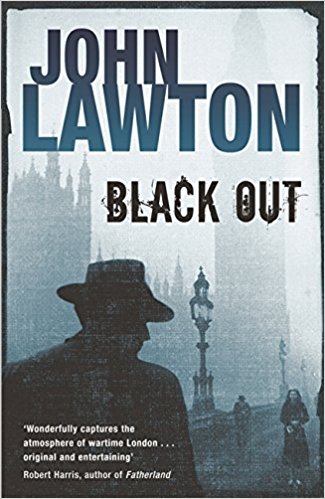
There is a large and intrusive US military establishment in London and it somehow seems involved In the mysterious deaths, so Plod noses around there, too.
There is much to’ing and fro’ing down mean nocturnal blacked out streets, many low lifes taking advantages of the circumstances, some patriots, and a lot of stoics hanging on.
I never did understand what the villain was doing and there is no wrap up at the end. What motivated him in targeting those three men remains unknown to this reader. Still less could I tell if his motivation was offical business, entrepreneurship, or just sadism.
Likewise I could not fathom his living doll who dutifully seduces Plod and then tries to kill him.
The author has more success with some of the supporting players like the wooden top who deals with the first murder, and the US army sergeant, though she is shallow, at least she has some vitality but her backstory was superfluous and she would not have worn battle dress in an office. I also like the brief role of an army guard who holds up Plod while Ike gets into a car.
That Plod is too dumb to realise the two women he has his way with are using him, is nicely done but in the end I am not sure that was intentional on the part of the author.
Plod’s own backstory which is parcelled out throughout the story is tedious and irrelevant, though it could have connected to that of the sergeant with some thought. Missed opportunity there.
The coda in Berlin was just too long a stretch. This reader was through long before that but kept reading hoping for enlightenment about the plot but none came.
 John Lawton
John Lawton
I liked the setting and set up enough to read another.
‘Unearthly Stranger’ (1963)
IMDb metadata: 1 hour and 18 minutes, 6.6/10 @ 320 opinions
Funded from the tip jar at the tea room, the sets are bare, the effects ordinary, but the scene is well set and there is enough mystery to hold interest. Strangely, John Carradine is not in it.

It opens with a wide- and wild-eyed man in fear running down a dark and empty street. He looks back as if he is pursued. In a close up, John Neville is bathed in sweat. A paranoid atmosphere is established with a minimum of fuss. Neville ascends a circular staircase, working up more sweat, bursts into an office and starts a reel-to-reel tape recorder to tell the story in flashback.
Neville is a scientist in the Space Research Centre somewhere in Britain (where the streets are devoid of cars).
We learn in the flashback that he has just been promoted to the top job and that he has also just got married after a whirlwind romance in Switzerland. Is the conjunction of these two events a happy coincidence? Or has the script writer set it up? Guess!
The Space Research Centre consists of a receptionist, a large map of the moon on the wall, two offices, a chrome dome Philip Stone (who has been in everything), and Neville. His predecessor, whom we see ever so briefly, blew a brain gasket and died. Young, vigorous, and cheerful, yet he keeled over and the autopsy showed blood vessels shredded in his grey matter. Ouch.
Enter the rotund security officer,
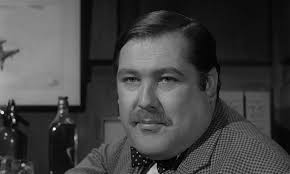
Mother (as he was later to be in ‘The Avengers’), who tells Chrome Dome that a number of astro-scientists have blown brain gaskets in England, USA, and the USSR, though this latter report is suspect. Is looking at a large map of the moon the cause? What other explanation could there be, Erich?
Well, the fraternity brothers took a look at the wife. Ah ha! Turns out other brain-blown scientists also had new wives. Oh, ‘nocturnal over exertions may be the cause,’ they cried. Rotund does not even consider this obvious line of peeping.
Neville, eyes turned to the heavens, speculates that ‘they’ (hint) up there may not want us to get there.
However, attention now swings to Wife. It seems Neville knows nothing about her, ahem, apart from that, and it also seems, as he gradually realises, she took all the initiatives that led to the marriage. What he just assumed was his magnetism can be interpreted otherwise.
At times he seems to have suspicions of her, and at other times he is quick to defend her from Rotund’s insinuations. Neville is clearly in thrall to her. The fraternity brothers terminology is not suitable for a family blog like this.
But even the smitten Neville admits she has quirks. She sleeps with her eyes wide open all night. (Androids do this in other films.)
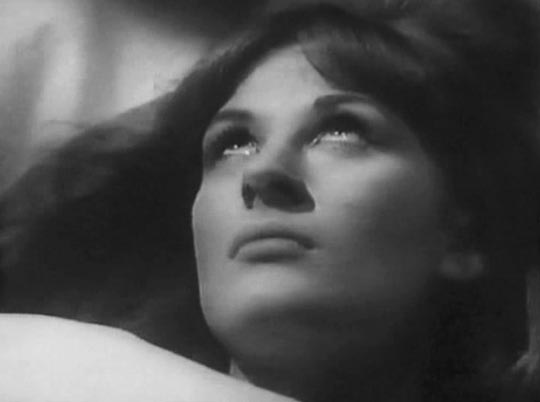
Okay. She has no pulse. Okay. (The fraternity brothers immediately spotted that as a trait of Venusians, per ‘Stranger from Venus’ [1954], reviewed elsewhere on this blog.) Moreover, she grabs a red hot casserole from the oven bare-handed with no ill effects. Later, the tears she cries burn her skin. What does all this add up to? See title above.
Aware of these oddities, Neville manages not to add them up. Nor does he connect the dots to his earlier speculations about what ‘they’ up there might not want. Thrall, indeed.
Wife gets misty at the sight of children. Hence the tears. Then when Neville cracks the formula for something crucial, who knows what, more tears come, because…. It is time to blow another brain gasket.
Spoiler.
She is indeed one of ‘they’ on a mission to stop the Space Research Centre from meeting its KPIs. In cinema-land few, if any other, aliens are women. What we get here is an alien who is conflicted, who has compassion, who has maternal instincts, as well as asbestos hands. This is a rarity in the Sy Fy genre. While some come in peace and do good works, no other alien to date falls in love and finds life on Earth good enough to stay. Wife does not want to hurt Neville, and she would like to have children.
Okay, okay. This is a pre-Liberated Woman who just wants to be a wife, homemaker, and mother, but in the context it is a volte-face. Of course, the fraternity brothers had a lot of questions, which are best omitted, about alien women.
When she wimps out of blowing up Neville’s brains, the receptionist steps in. Turns out for the last twelve years she has been erasing the blackboard every night, so that the scientists have had to start the formula over each day. This trick is called a Penelope among the Sisterhood. None of the big brain scientists have noticed this, not even the chrome dome boss.
However Chrome has figured how to overcome an alien. He grabs a sock from the laundry basket and the odour drives her to jump out of the window. Phew! Whew! Like Wife, she just vanishes. There today, gone today.
But there are plenty more aliens in the sea, since the last shot is of a group of women having a look. Gulp! Are they more of the Lunar Sisterhood? We’ll never know until the sequel.
No one smokes. Now that is odd in a piece from this period. No pipe fiddling. No cigars, No cigarettes.
Some reviewers call this an alien invasion film, but not so. there are aliens on Earth as agents of influence, but there is no invasion, nor a threat of one as long as the blackboard is kept clean over night. Brains are then safe.
The Cold War is there in the distrust of the Russkies, but the aliens are not a metaphor for them, or are they?
‘The Year of the Sex Olympics’ (1968)
IMDB meta data: run time 1 and 45 minutes; scored at 7.3/10 by a paltry 124 voters.
‘Coming sooner than you think,’ is the opening title card. About time, cried the fraternity brothers!
Made fifty years ago, this film is an anticipation of reality television, even before ‘Death Watch’ (1980).
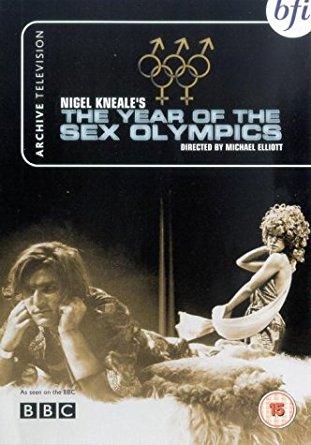
The set up? The televised trials for a place at the next world Sex Olympiad are underway in a television studio. Watched from a control room by the bored producers, clad in paisley pajamas, who are dedicated to keeping the viewers apathetic in a society where
‘it is better to watch than to do.’
They watch and so do we. The vicarious sex on the telly is to sate the libidos of the audience so that there is less reproduction. (Pornography has never done that for the fraternity brothers.) There are other sex program catering to the artistic. Another program is aimed at reducing the appetite for food through custard pie throwing. Very Three Stooges. There is a joke about this in the credits with a long list of consultants on pie throwing, including Bernard from ‘Yes, Minister.’
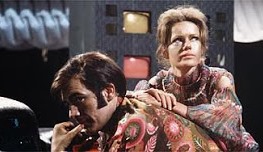 Those jammies.
Those jammies.
In general the purpose of television is to quell the emotions, drives, and impulses of people because they cause conflict. The goal is a quiescent society. like Canberra on Saturday night.
This situation has gone on so long that the current generation we see no longer seems to know the larger context or purpose or the historical evolution of the industry and the society it serves. It just is this way.
Everyone speaks a clipped functional language. The television producers are High-Drive people. The audience they cater to consists of Low-Drive people, the vast majority. That translates readily to the world of Channel 7Mate where the producers cater to an audience they despise and make millions doing it. No one goes broke underestimating the tastes of that demographic where urine drinking is a competitive sport.
Finding the balance in this television game is tricky. Nat with eyebrows that often speak for themselves is pressured from above by the Controller, a standard BBC term, to improve his programs and threatened from below by a underling who wants his job. Situation normal in an organisation but mercifully this depiction is pre-KPI so there is no cloudy and vague McKinsey-speak further to confuse matters in the name of clarity.
Two disruptions occur. First an artist arrives in the studio and he wants to upset people with horrifying pictures. Think of Evard Munck’s ‘The Scream’ or the Twit in Chief smiling. Ugh! These people are indeed horrified by the art. The studio High-Drives are so cocooned they have never seen an unpleasant sight. The artist tries to disrupt a broadcast to show one of his pictures and becomes one himself when he falls to his death!
Eyebrows, however, finds the pictures fascinating, albeit unsuitable for broadcast. He is, perhaps, not quite as superficial as he seems, then into his life comes a personal crisis when a child by his first wife is tested as Low-Drive, which will reflect badly on him. He has no interest in Ex or Child except as they show in his file. He is a very model of a modern McKinsey manager avant le mot and only thinks of his KPIs.
The idea emerges of isolating a couple on a deserted island amid cameras so that viewers can watch them cope. Eyebrows and Ex volunteer with Child. These three missed Scouting and know nothing. They do not know what fire is let alone how to start and maintain one or to pull a vegetable out of the ground on the windswept rain-soaked island in Holland Park to which they are consigned.
They have copious instructions from Wikipedia on an iPhone which are frequently consulted. Eyebrows had an iWatch in the studio bit he did not take it to The Island where he went low tech.
The program is called ‘Living Life.’ The audience finds it amusing and it is a hit. The audience by the way is represented by a focus group of twelve garbed in pink sweatshirts and pants. These are the Low-Drives of Channel 7Mate.
Without the professor from Gilligan’s Island, Eyebrows and Ex are hopeless. They have been spoon fed so long that they only know the shape of the spoon. Child falls, breaks an arm, and slowly dies of an untreated infection.
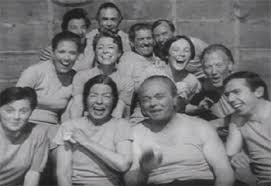
The sweatpantsers find that hilarious. Ratings soar. (See, like ‘Death Watch.’)
The inevitable comparisons are the E.M. Forester story ‘When the Machine Stops’ and George Orwell’s ‘Nineteen Eighty-Four.’ Though as to the latter, there is no hint here that there is a regime oppressing people per Orwell but rather a commercial enterprise giving the Pink Sweatpants Nation what it wants, when it wants it, and how it wants it. Is not that broadcast populism, or democracy? Responding to what the people want is one definition of democracy.
This is another gem from the fecund typewriter of Nigel Kneale. The players include Reginald Perrin and the estimable, but here very young, Brian Cox. I found it on the Internet Archive.
It was filmed in colour but only a black and white archival print remains. The expensive colour film was reused though why the BBC did it in costly colour at a time when there very few colour televisions to see it on is anyone’s guess.
Inspired by this viewing, I will look for ‘Death Watch.’
‘Space Trucker Bruce’ (2014)
IMDb meta-data, 1 hour and 27 minutes, rated 5.1/10 from 60 voters.
A road movie in space as the lonely space trucker Bruce with 20,000 tons of Iowa hog fat picks up an escape pod passenger. Not quite a hitchhiker but close to it.
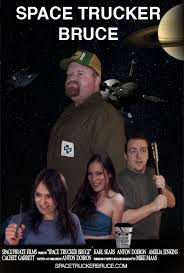
They get to know each other and then they encounter The Dark Object and they struggle to survive. They bond. Bruce is in the Channel 7Mate demographic.
Moral, space travel is boring. Subtext, watching boring space travel is boring.
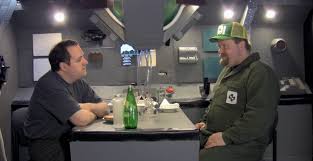
Very.
This is a no budget exercise written, produced, directed by one of the actors. See. It was posted to You Tube by the maker by way of a release.
I managed to watch it to the end but then, strangely, forgot about it until now quite a time later.
Not to be confused with ‘Space Truckers’ (1996), which on the IMDb ranks at 5.2 or a mere 0.1 higher despite its much bigger budget and some fine actors, e.g., Dennis Hopper, Charles Dance, and more.
‘Mission Stardust’ (1967)
IMDB metadata: 1 hour and 37 minutes @ 3.9 from 479 friends of the producer.
Half Sy Fy and half an ersatz James Bond thriller from Italy.
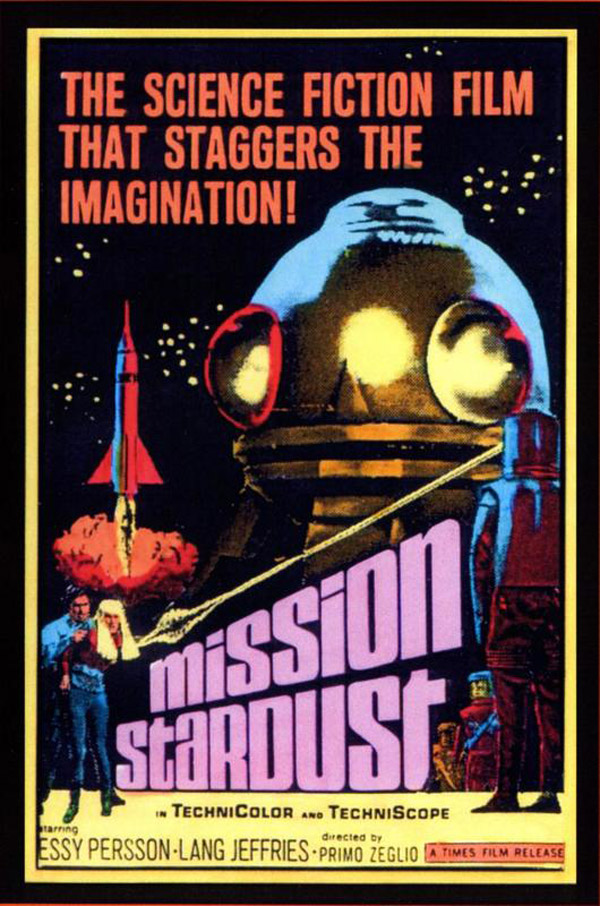 ‘Staggering?’ No more like numbing.
‘Staggering?’ No more like numbing.
The first Earth flight lands on the Moon, and its four-man crew sets out to do some science, collect samples, survey, map, and gawk at Terra. (They do not light up.) But they are not alone!
There is another ship, a round June bug with external retracting landing gear. The fraternity brothers thought it was cute, more so later when it gave birth.
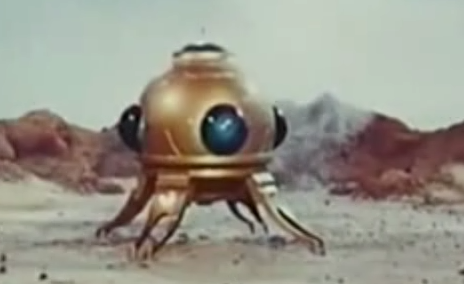 The June bug on the Moon.
The June bug on the Moon.
After a standoff, two of the Terrans meet the aliens who are as insecure as Ivy League graduates who have to tell everyone immediately and repeatedly that they are Ivy League graduates, and boast again and again about their superiority to the Earthlings. Superior, maybe, but tactful not. The chief proclaimer is a chump-cha Twiggy in a platinum wig. In addition there is a wise old owl, and robot who seems nicer than Twiggy and smarter looking than the wise owl. Pretty sure that wig was used again later in ‘Sette uomini d’oro nello spazio’ or ‘Star Odyssey’ (1979) without Twiggy underneath.
‘Superior,’ did she say, time after time, and yet they can’t change a tire on the spaceship, which is why it is stuck on the Moon waiting for some road service retards from Earth to wander by. How superior is that! The Terrans volunteer to change the tire, while Twiggy repeats the scriptwriters mantra. Owl gets all faintly and the Terra doctor notices he has leukaemia. Tire changing will do that.
Twiggy and the Earthmen join….forces to treat the disease in the owl. Because they are so superior the aliens have neither a doctor nor medicine. Did she say superior? Well maybe it is a superior form of leuekmia, which the fraternity brothers thought mainly afflicted the young. Mr Owl is no spring owl.
Best treatment for leukaemia on Earth is to be had in Mombassa. Mom bosa? In Kenya. Sure.
The big June bug ejects a mini June bug and an away mission to land in east Africa. Twiggy brings along one of the really big-button remoters for geriatrics just in case. Superior technology, not! It gets put to good use.
The wise old owl goes on about the union of the two peoples of Earth and owls. The fraternity brother responded to that idea with enthusiasm.
There we switch to James Bond, complete with a villain sporting mirror-shined loafers and stroking a hairy pet. Blofeld slumming. Another wanna-be villain.
It’s like this. The Superior Beings with a flat spaceship tire and leukimea have a stash of diamonds. Blofeld knows this because one of the four Earthmen contacted him to rat it out. (Disclosure statement, I fast-forwarded past this revelation, so that is my interpretation based on what happens next.) Blofeld also knows that they are going to the clinic so he plants his killer nurses there with Uzis up their… It’s a trap!
Earlier the army had wasted screen time trying to blow up the ship, the robot, and the director’s chair. Something. Anything.
Later there is confrontation and shoot out on the Moon. The traitor gets it. Blofield gets it. Twiggy gets it.
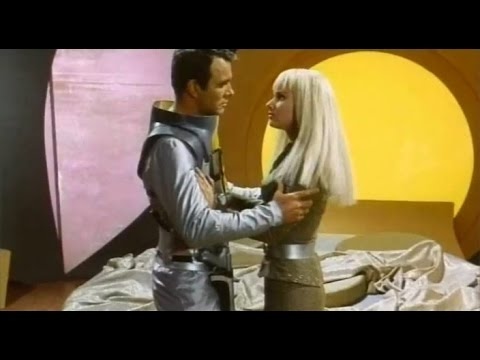 Union at last. The end.
Union at last. The end.
Never seen anything quite like it. It is a genre mongrel, part drive-in Sy FY and part low-budget James Bond. There are other mongrels in the Sy FY kennel, usually noir thrillers like ‘The Atomic Man’ or ‘The Amazing Transparent Man’ and others that blend with musicals, krimis, ghost stories, and …..
The levitation effects were fun. The robot unmasking was neat. The June bugs large and small were cute. It must have used everyone in Kenya as an extra.
But, really, 3.9 seems high.
‘The Stars, My Destination’ (1956) by Alfred Bester
A bildungsroman of sorts as Gully Foyle grows and changes with his experiences, and the greatest changes occur at the instruction of women. The first is the one-way telepathic black woman whom he rapes and, in a way, sets free. Later they form a team of convenience. The second is Jiz whose influence on him is considerable, making him grow and change. Finally is the White Icicle who attracts and repels him in equal measure. Least influential but last is Moira, the stay at home.
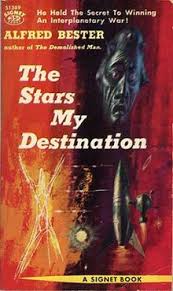
Gully begins the story as an uneducated barely verbal spaceship hand on the Nomad. Think of the channel 7Mate demographic without the drooling and scratching and you have him. By the end he is richer than all the cynics who own Channel 7Mate put together.
The Nomad is a wreck floating in space and Gully alone has survived the attack by dumb luck and a resourcefulness he did not know he had. A friendly spaceship hoves into view and he signals it, quickly and repeatedly. Yet it passes him by, contrary to all the laws, rules, norms, and ethics of spaceflight.
Thereafter he swears revenge on that ship. Driven by that desire he survives, and later prospers, and learns, and seeks the guilty ship. The adventures are many, the plot twists are deft, the characters differentiated, the settings detailed and followed through, and the science fiction is etched into the story and the characters.
The first, and as it turns out, the last key, to the narrative is that in this world of 2550 teleportation is as common as walking is today. To move from one place to another one teleports oneself, clothes included and anything one is carrying or holding. Distance varies with ability and practice. It is safer than walking since there are no crazed drivers on King Street to dodge. The method is a mental discipline developed by a Mr. Jaunte, and so it is ‘to jaunte.’ The telekinesis involved is crucial to the narrative and the denouement.
There are three treasures in this quest. First is a vast fortune of Credits 20 billion, where a hundred credits is a great deal of money. Second is a rare mineral that releases vast quantities of energy, far exceeding uranium and its mutant cousins. Third is Foyle himself, much to his own surprise, and to the reader, too.
There is much satire of the super rich, so much it grew tedious to read, but it is fitted to the overall plot like a jewel in a ring. In a world where movement is by thought conspicuous consumption to signal one’s riches becomes conspicuous transportation.
Nicely embedded in that satire is Foyle’s hiding in plain sight for a part of the time, as the most ostentatious and conspicuous transportee, while he seeks leads to the hated ship. Although his choice of an alias was a quick and certain give away it took the villains a long time to figure it out.
There are also a couple of surprising passages for a 1956 publication about the role of women in this wealthy society, sequestered, hidden, and rather like pets in a zoo. None of that applies to the first three women whom he encounters, though the last one is of that sort of society. Finally he returns to Moria as we all do. One is an illegal immigrant and the second a convict.
Without any explicit comment, Bester also shows a society with deep, very deep class divisions so that members of the working class where Foyle started, are barely educated, civilised just enough to do a job like living machines. Indeed he is so dense that at first the target for his vengeance is the spaceship itself. Only later does understand that the crew made the decision and then he targets them, but in time the realises that the captain gave the order.
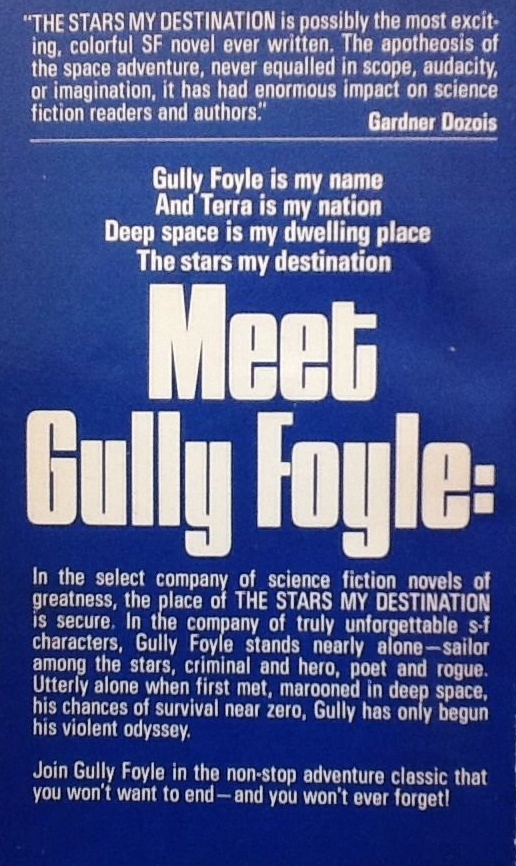
There is no preaching by the author but the reader gets that point. So much Sy Fy is spoiled by childish preaching by the author using the keyboard as if it were a sledgehammer to drive points home to the dense reader all too much like the morons on Fox News yelling at the camera.
 Alfred Bester
Alfred Bester
Another flaw that has stopped me reading a few Sy Fy titles is the ostentatious erudition that some author parade to show how clever they are, like the pointless CGI of so many movies, but which advances neither plot nor character. This title is free of that egomania.
That it opens with an excerpt from William Blake’s most famous poem which is integrated into both plot and character.
I read it in an adolescent Sy Fy phase but had forgotten all the details.
By the by, holding physical objects accountable for the consequences arising from them may seem absurd to us — we know the spaceship itself did nothing — but Athenians did not. A building block that fell and killed some would be tried, sentenced, and smashed.
‘Zontar: The Thing from Venus’ (1966)
IMDb Metadata 1 hour and 20 minutes of Dali Time, rated 3.0/10 by 670 time wasters.
‘It Conquered the World’ (1956) was Zontar’s first effort at Terra domination. But Zontar had a sibling and here it is. Sexing Venusians is beyond even the fraternity brothers, so we will leave it at ‘It.’
The Dallas production company copied ‘It Conquered the World’ nearly line by line and scene by scene, except at the coda. It is not a continuation of the previous story but a tired and trite repetition of it. The plagiarism is so literal that it even includes the same 1950s ethnic accents for some of the most minor characters. However, the decor, fashions, hair are all of the 1960s.
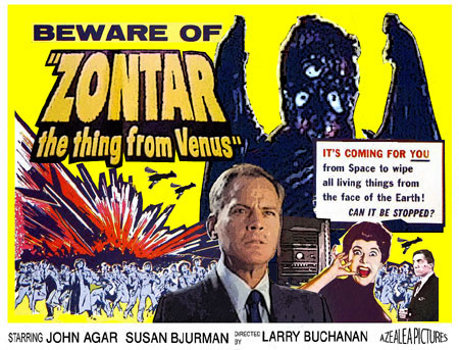
John Agar, about whom more below, saves the world once again, single-handedly as he prefers. This is done after his wife and his friend try to kill him. Macho Man that he is, he kills his wife, but bonds with his friend. Is this man-love?
The acting is uniformly wooden. Agar is the exception; he is robotic: stiff and mechanical.
Copied yes, but the homily at the end differs. Most Sy Fy films have some kind of coda. At the end of ‘It Conquered the World’ Peter Graves told audiences that humanity would prevail because humans have feelings, emotions, compassion,…. [ad nauseam]. In this outing, Agar’s text does not celebrate all that girly New Testament stuff, but declares humanity will endure because we think, reason, do science, and such. Hooray! Banned in anti-Vaxxer states across the nation.
That pulled me up short. While ‘It Conquered the World’ is a better movie, this is a better message.
‘It Conquered the World’ is a better movie at 4.9 on the IMDB opinionmeter, though in the basement, because it has much more energy, vitality, momentum, and tension than this leaden exercise.
Once again John Agar’s (1921–2002) feet do not touch career bottom. He kept it up for nearly another forty years! For a man who was second to John Wayne in ‘Fort Apache’ (1948), ’She Wore a Yellow Ribbon’ (1949), and ‘Sands of Iwo Jima’ (1949) this is a long way down. After marrying America’s sweetheart, Shirley Temple, he found a greater love in the bottom of innumerable bottles of alcohol, so the story goes, and that love ended his marriage and put dent in his career.
The titles indicate the substance of this selection of his oeuvre.
‘Revenge of the Creature’ (1955)
‘Tarantula’ (1956)
‘The Mole People’ (1956)
‘Daughter of Dr Jekyll’ (1957)
‘The Brain from Planet Arous’ (1957)
‘Attack fo the Puppet People’ (1958)
‘Journey to the Seventh Planet’ (1962)
‘Women of the Prehistoric Planet’ (1966)
‘Curse of the Swamp Creature’ (1966)
In most of them he played an authority figure, a scientist or an army officer, something he never was.
That career came as a result of his marriage. After he married Temple, her studio hired him, put him through acting school, and cast him in his first film, ‘Fort Apache.’ When she divorced him friends like John Wayne tried to help him with work but the shambles continued. Despite it all he kept acting, in his way, when not in jail for drunk driving, assault, harassment, stalking, petty theft, and such, yet he has a long list of roles on the IMDb, the last released in 2005 after his death. He is another Hollywood high diver. Started out on top and plunged to the bottom in no time at all.
According to the cinema oracle, IMDb, there is a Zontar Television series. Tempting….
‘Invisible Invaders’ (1959)
IMDB metadata 1 hour and 7 minutes @ 5.0/10 from 1246 time wasters.
‘The aliens are coming! The alien Russians are coming!’
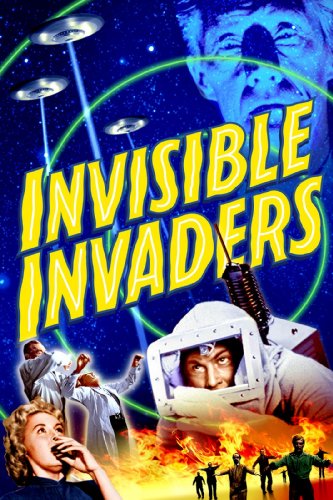 The lobby card misleads. As usual. There are no zapping flying saucers.
The lobby card misleads. As usual. There are no zapping flying saucers.
The Cold War is very cold and John Carradine, with his cadaverous appearance and other worldly voice, leads the spooks once again.
He was a nuclear scientist who adds sugar to his radium and blows himself up. Sad. His dear friend and colleague ruminates on the morality of atomic weapons in the aftermath with his comely daughter and Igor. B o r i n g.
To liven things up comes the Zombie Carradine, looking even more cadaverous and spooky than ever with the pancake makeup. No, he does want a cup of coffee. He is there to lay down the law. His dead body has been put to work.
This Lazarus is speaking for the otherwise Invisible Invaders (the I-Squares) who live on the Moon, and have done so for squillions of years (without paying a cent of rent). Not even the really big telescope at Mount Palomar that Bruce Bennett used when Carradine was the ‘Cosmic Man’ (reviewed elsewhere on this blog) could see them or their works. They are INVISIBLE. (That is music to the film’s producer because it means no special effects budget is required.)
Indeed the main effect is shuffling foot prints so we know the Zombie alien is coming. It seems the Zombies are invisible, too, well, some of the time but not always. Consistency is not a Zombie virtue.
The budget cutters have been at work on the Moon, and to economise the I-Squares are using the Earth’s dead as Zombies. We are told often in a radio voiceover that there are hordes of them rampaging around killing the living to convert them into Zombies to meet their KPIs, Killing Performance Indicators. Yet we only see six of them, all men in suits with neckties and all of them 1950s whitebread. We see them about six times. It looks like two takes, repeated and repeated, one coming down a slope and one on the flat, all in Bronson Canyon. The property values never recovered from this exercise.
Why do the I-Squares want to depopulate the Earth? Are they anticipating the Solar contamination of Paris Hilton? The fraternity brothers have no idea. Situation normal.
Carradine is not there to negotiate, just to threaten. He tells his ruminating old buddy to call on world leaders to surrender and be quick about it, which his buddy does by going to D.C. to pass the word where he is laughed out of court. The carrion the press join the fun with spinning newspaper headlines. Situation normal.
Though the threat is global we only see the Yankee response. Not just whitebread, but only Yankee whitebread.
‘No more Mr Nice Guy,’ declares an disembodied Carradine (whose body has now gone onto to another gig), and the I-Squares begin inflicting disasters on the world. First, they take ‘I Love Lucy’ off the air and riots follow. Then they cause the New York Yankees to lose the pennant. Can it get any worse?
Yes, Richard Nixon gives speeches. Aaargh! Enough. There is stock footage of fires, floods, and famines that result from Nixonionisms.
Now D.C. responds by throwing all the resources of the mighty Federal government into the problem. These resources are: one ruminating, aged scientist, his assistant Igor, his daughter who bites her knuckles, and John Agar, proving there is no bottom to touch in his career descent. There is also one jeep and a panel van, and one, only one, radiation suit. That’s it. The Boy Scouts were always better prepared for Armageddon than that.
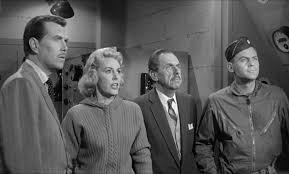 Life on Earth depends on these people!
Life on Earth depends on these people!
This is the Arsenal of Humanity? Blame the budget cutters! Fortunately, they have an in with the script writer. Plus now that Carradine has gone, the Zombies are not only stiff-legged, they are stiff-brained. There is no ethereal voice to scare everyone.
Despite the absence of Whit Bissell from the lab, the aged scientist hits on the killer weapons for the undead dead Zombies whose bodies are inhabited by the spectral I-Squares.
Taking a page from Bissell’s lab manual in ‘Target Earth’ (1954) (reviewed elsewhere on this blog), the aged ruminator prepares a sound ray. (Hey, that is what it is.) It focuses Beach Boys songs onto the Zombies and the ‘Good Vibrations’ are too much for them. They are driven from the cadavers and die. Die, alien, die! The fraternity brothers liked that.
Igor chickens out but recovers. From this episode we know he has no chance with the knuckle-biter. Agar sleepwalks through most of it, and his stunt double in the radiation suit does the heavy lifting. But there is no doubt he got the girl.
While the I-Squares are Reds in invisible disguise, they are so geriatric with all the foot dragging that, well, they would fall over their own feet. If left to roam around they would eventually do themselves in.
The sets are empty. The film editing leaves in much that should have omitted, like the firing range targets in some of the explosion footage. Most of the, er ahem, story is told through radio voiceovers. Always a sign there is no sound technician getting paid. The direction is static, usually a sign of one-take. No one moves once the focus is set, so that it does not need to be pulled again. The screenplay is…. (what is the right word…) absent.
John Carradine must have been working off some gigantic karmic debt in doing all these one and two day gigs in Z grade films. This would have been half a day for an old trouper like him.
John Agar, well, what more can be said. He is another Hollywood high diver. Once a second lead to John Wayne, he fell to these catatonic depths. He is leaden here, no doubt responding to the director’s orders. I have described his descent in another post.
The director is that speed merchant Edward L. Cahn who could turn these things out in five days or less, much loved by producers for getting it in the can. He could do fifteen of these a year, but no one can watch that many in a year, and retain sanity. I could not find a picture of him on the inter-web.
That the IMDbasers give it a 5.0 average irritates, since the better ‘The Cosmic Man’ (1959) is 4.7 where Carradine brings an interplanetary Marshall Plan.
‘The Cosmic Man’ (1959)
Metadata from IMDB: 1 hour and 12 minutes, 4.5/10 from 302 opinionators
A shadowy figure offers world peace and an interplanetary Marshall Plan, while curing a polio-stricken youngster, and in return is then gunned down by men in uniform. Ah, the 1950s when the worlds were so much simpler.
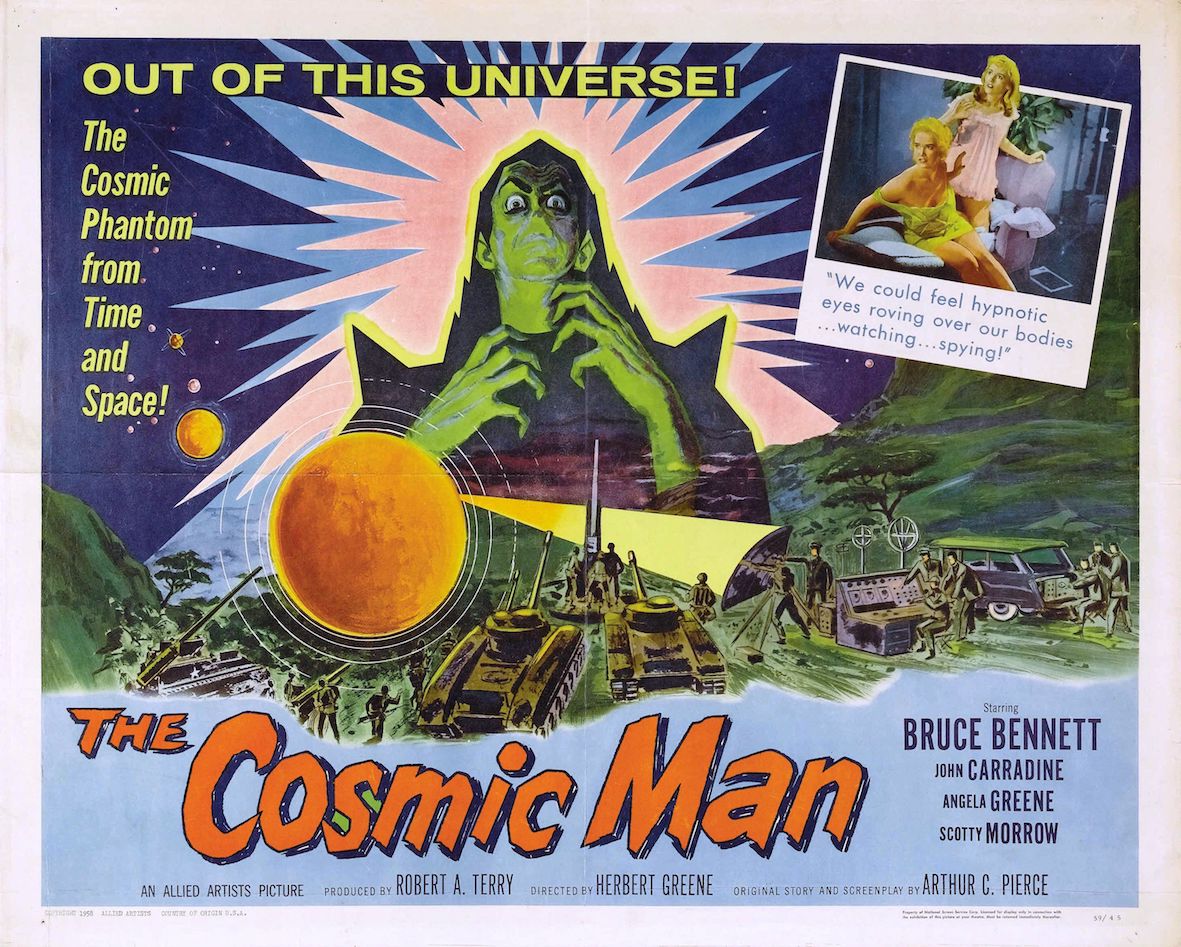 This lobby card wins first prize for irrelevance to the movie it purports to summarise. There is no spectral green figure in a cape, and the insert in the upper right refers to a ten second blur.
This lobby card wins first prize for irrelevance to the movie it purports to summarise. There is no spectral green figure in a cape, and the insert in the upper right refers to a ten second blur.
While it repeats the tropes from many of its Sy Fy genre stablemates there are elements that appeal to viewers over the mental age of the fraternity brothers. (Think of them as part of Channel 7MATE demographic for whom ‘Top Gear’ is high culture.)
Before the twists, the set up. An orb is found suspended in mid-air in Bronson Canyon, a favourite Hollywood locale where Randolph Scott dealt with many a villain.
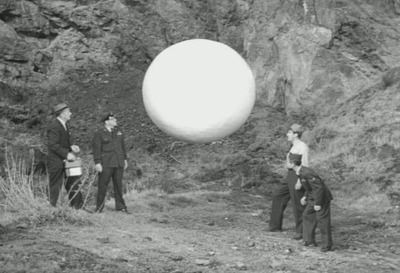
It looks like a large golf ball without the dimples.
‘Can’t have that,’ declares Smokey, the park ranger. It might fall on someone. Unbeknownst to millions of visitors to Bronson Canyon there are many secret atomic military bases in the vicinity, and Smokey calls in the police and they call in the uniforms. A Commie plot is suspected in all but word. No one thinks to call Sam Snead, the golf ball expert of the day.
Someone also calls in Herbert Brix, a scientist from Mount Palomar, who is shown driving out of the parking lot of this famous installation, not once but twice, in exactly the same film footage. There are no interiors of the big telescope there.
Thereafter the colonel on the scene and the scientist spar over what to do. The colonel wants to contain, capture, control, crush, cut, and do other manly things to the sphere, which continues harmlessly to hover.
Brix wants to think, to look, to inspect, to test, to speculate, and to do science, perhaps even communicate with the owner of the golf ball.
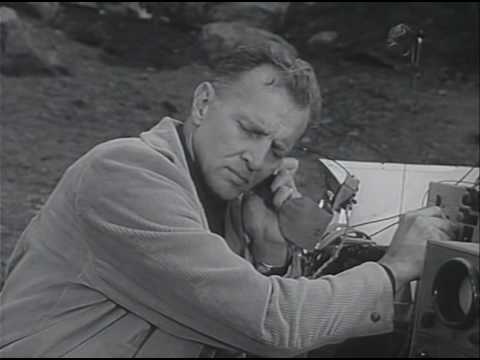
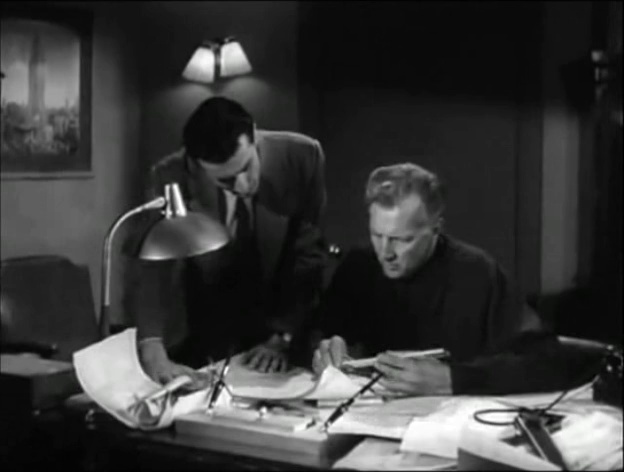
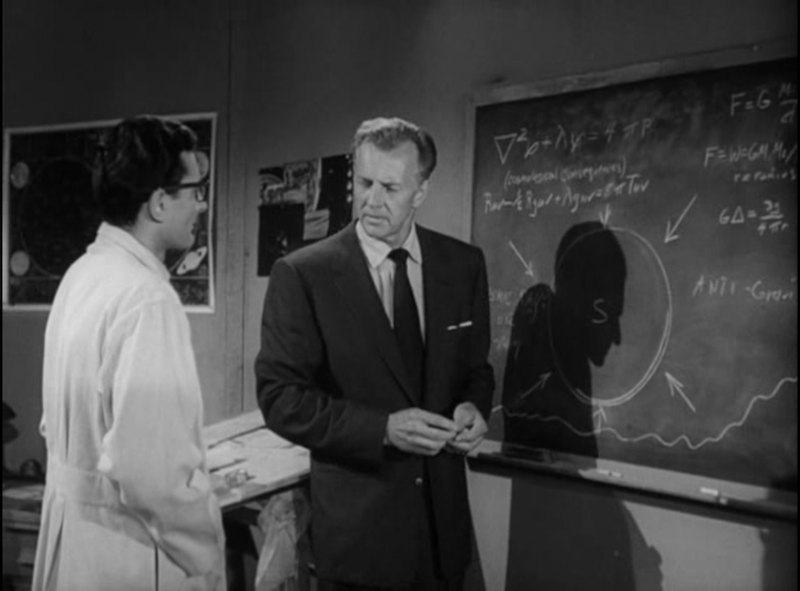 Brix doing science.
Brix doing science.
‘Thinking! Who has got time for that,’ bellows the colonel! ‘It is a threat!’ (The fraternity brothers have always had their suspicions of golf balls because they always seem to be guided by unseen forces.) But the colonel’s efforts, adumbrated above, are ineffective, so reluctantly he listens to Brix.
Brix surmises from no evidence apart from the script that the golf orb came in peace and is a vehicle and that its passenger has disembarked through the forward, invisible door. The colonel telephones the general, who is too lazy to come and see for himself, for ever more soldiers to find this infiltrator. A cordon bleu is thrown about Bronson Canyon much to the annoyance of Charles who lives there.
The soldiers and more scientists converge on the spot and put up in an inn whose widowed proprietor has a crippled son of, say, ten or eleven. Dad was canceled in the Korean War a few short years earlier and the widow took the payout and bought the inn where she can attend to her boy. It is out of season but now she has a full house. Cha-ching goes the cash register.
Meanwhile, a peeping Tom seems to be about, causing much consternation among the citizenry who pressure the police, who pressure the mayor, who pressures the army which pressures the scientists. Much pressure to Do Something.
With all the coming and going at the inn another fellow shows up, rugged up in an overcoat, a floppy hat, and wearing coke bottle glasses.
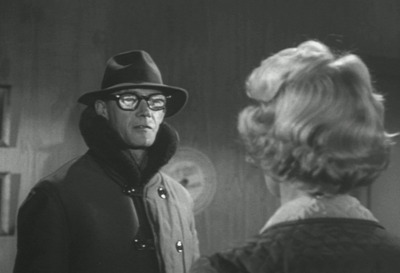 What else could he be but a scientist in that regalia.
What else could he be but a scientist in that regalia.
He speaks in the voice of John Carradine. Shiver. He speaks ever so slowly and formally that we know right away he is not of this vernacular. The widowed proprietor mistakes him for another scientist and gives him a room in the back where he can rest. We know he is golfball orb lagged from his travels.
Brix tries to reason with the colonel, and the colonel listens and even rebuts part of Brix’s argument. Nice. Reason.
Enough! Carradine’s two-day contract means he has to hurry up and spill the cosmic beans. When the whole group is gathered in the inn, JC dowses the lights and reveals himself as the Comic Man, the first of the cosmonauts. Yes he uses that last term, which latter became identified with the Soviet space program so he must be a Commie. He warns against nuclear weapons and war, and offers the help of the Cosmonauts in development that will lead to world peace.
He does not exactly reveal his very own self since he is invisible, being from another universe, dimension, bad dream, or something. Or maybe he is the prodigy of the Invisible Man and Invisible Woman as reviewed elsewhere on this blog.
To Brix this message fits with the low key way the Cosmic JC has been going about things. First Contact is always tricky in Sy FY. First the alien has been trying to scout the place, steal some of clothing, and drink some coke to get those glasses.
To the colonel it is Yalta all over again, once more. This peace will be slavery. Better dead than contented! That seems to be his motto.
Meanwhile, JC has taken a liking for the crippled boy who teaches him to play chess. Nice.
Having seen enough, JC prepares to depart. In so doing he takes along the boy! Alien-napped! A hostage! The worst possible interpretations flow fast and furious. The colonel is ready to nuke the place! Better to destroy the boy than lose the boy.
JC puts aside the boy and as he alone approaches the golf ball orb he is blasted by the United State Army! Makes a Twit proud to see one harmless old man chopped down.
In a nice touch, the switch is not thrown by the colonel, but by another scientist called in by the colonel because Brix is such a sissy. This scientist does it, he says, because he want to detain JC. Ah huh. Intentions aside. JC is cooked. He disappears into the dust, and blink, the golf ball orb is gone.
The boy, on his feet, walks to his mother because he is now cured of his disability.
Whew.
It was not clear to this jaundiced viewer if the colonel got the message about the boy, or if he cared.
Nor is it clear what the other cosmonauts will do now that JC is dust. But no one in the script seems worried about that.
Meanwhile, the slow but sure Brix has insinuated himself with widow. The colonel can tell the general he will not have to move.
It is easy to see this tale as social criticism applied to the trigger fingers of all those uniforms. That was risky in those days of Cold War uniform worship.
It is also refreshing in the Sy Fy genre to see a scientist who is not mad and who is not completely ineffectual. The colonel, having seen many other Sy Fy movies supposes Brix is ineffectual because he does not understand what Brix is doing. In fact, his science is what provokes JC into revealing himself and it is mainly to him that JC speaks. This annoys the bristling colonel no end. He and his men try to shoot JC in the dark after hearing this Yalta message.
Generally in Sy Fy, there is no science at all, a mad scientist who started all the trouble, or a bunch of clipboard-carrying do nothing scientists. Brix is none of these.
His brief conversations withe colonel make sense.
One critic speculates the John Carradine must have been working off an enormous karmic debt by taking every part in every bad movie he was offered. He certainly did.
The critics linked to the IMDb page deride the film for its poor special effects. It is after all a magnified gold ball and some claim to see the dimples. The shadowy shots of the invisible Carradine are mostly murk. As a creature feature, it lacks a creature, despite the lobby card above. Moreover, there is little ka-boom to keep the retards happy.
However, its biggest sin on the keyboards of these critics is that it repeats the message of Klaatu from ‘The Day the Earth Stood Still.’ Peace on earth, good will, and harmony for all. ‘Boring,’ cry these critics. ‘Been done,’ they say.
What clots!
There are no original stories. It is how the tale is told that makes it interesting, and this low-key telling with some respect for science and scientists is out of the ordinary. The romantic element does not get in the way of the major plot, whereas in many films that would have been the cause of tension between Brix and the colonel. While the widow does a scream or two, she is mostly window dressing. The tension is about what to do and nothing else. The paraplegic boy is integral to the plot but not a tear-jerker.
That is, the elements are in balance and the focus is always on the main plot. Aristotle would approve.
It is noteworthy how little science there is in many Sy Fy films. The aliens appear and the cast blasts them. Sometimes a lab coated scientist, inevitably Whit Bissell, fine tunes the blaster and bang, that is it. In many, there is no science at all. They are played as mysteries, or thrillers. Period. ‘It Came from Outer Space’ (1953), a personal favourite, has no science in it, after Carlson puts aside his telescope in the first two minutes.
Herbert Brix, ever heard of him? He was an Olympic athlete whose physique led him to play Tarzan in a film serial when John Weissmuller beat him out for the feature film role. Brix liked the life but, unlike many, realised his limitations. He quit and took acting lessons for some time, and then changed his name to leave behind his he-man persona and became Bruce Bennett, and returned to become an accomplished supporting actor. This outing would have been one of his few romantic leads.
He has a easy manner, a slow smile, a reassuring baritone, and fills this bill well. He supported Bogart in ‘Sahara’ (1943), ‘Dark Passage’ (1947), and ‘The Treasure of the Sierra Madre’ (1948). He quit a second time and went into real estate in California and did well. He is described on Wikipedia as a recluse who did not attend fan conventions, do interviews, reply to would-be biographers, and such as many retired actors do. He stayed married for sixty-seven years and died at one hundred.
